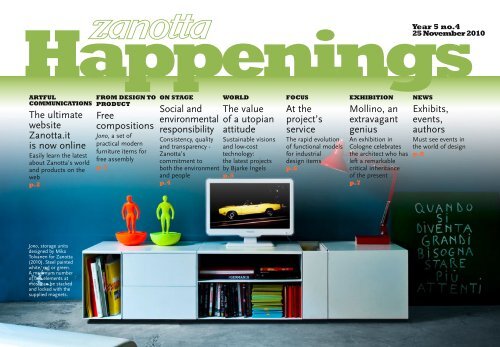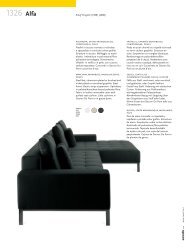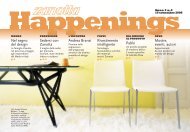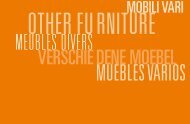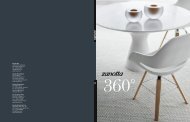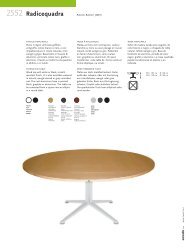newsletter 4-10 ingl_newsletter2 - Zanotta SpA
newsletter 4-10 ingl_newsletter2 - Zanotta SpA
newsletter 4-10 ingl_newsletter2 - Zanotta SpA
Create successful ePaper yourself
Turn your PDF publications into a flip-book with our unique Google optimized e-Paper software.
Happenings<br />
Year 5 no.4<br />
25 November 20<strong>10</strong><br />
ARTFUL<br />
COMMUNICATIONS<br />
The ultimate<br />
website<br />
<strong>Zanotta</strong>.it<br />
is now online<br />
Easily learn the latest<br />
about <strong>Zanotta</strong>’s world<br />
and products on the<br />
web<br />
p.2<br />
FROM DESIGN TO<br />
PRODUCT<br />
Free<br />
compositions<br />
Jono, a set of<br />
practical modern<br />
furniture items for<br />
free assembly<br />
p.3<br />
ON STAGE<br />
Social and<br />
environmental<br />
responsibility<br />
Consistency, quality<br />
and transparency -<br />
<strong>Zanotta</strong>’s<br />
commitment to<br />
both the environment<br />
and people<br />
p.4<br />
WORLD<br />
The value<br />
of a utopian<br />
attitude<br />
Sustainable visions<br />
and low-cost<br />
technology:<br />
the latest projects<br />
by Bjarke Ingels<br />
p.5<br />
FOCUS<br />
At the<br />
project’s<br />
service<br />
The rapid evolution<br />
of functional models<br />
for industrial<br />
design items<br />
p.6<br />
EXHIBITION<br />
Mollino, an<br />
extravagant<br />
genius<br />
An exhibition in<br />
Cologne celebrates<br />
the architect who has<br />
left a remarkable<br />
critical inheritance<br />
of the present<br />
p.7<br />
NEWS<br />
Exhibits,<br />
events,<br />
authors<br />
Must see events in<br />
the world of design<br />
p.8<br />
Jono, storage units<br />
designed by Mika<br />
Tolvanen for <strong>Zanotta</strong><br />
(20<strong>10</strong>). Steel painted<br />
white, red or green.<br />
A maximum number<br />
of two elements at<br />
most can be stacked<br />
and locked with the<br />
supplied magnets.
ARTFUL<br />
COMMUNICATIONS<br />
Happenings<br />
no.4/<strong>10</strong> p.2<br />
The ultimate website<br />
<strong>Zanotta</strong>.it is now online<br />
An invitation for a highly dynamic, easy to grasp<br />
discovery of <strong>Zanotta</strong>’s design world on the web.<br />
The website <strong>Zanotta</strong>.it has been entirely revisited<br />
and turned into a state-of-the-art user friendly<br />
search tool. With its outstanding quality of<br />
information and images, <strong>Zanotta</strong>.it accompanies<br />
web surfers on a fascinating virtual tour<br />
enhanced by refined, basic and easy to use web graphics and<br />
communication. This has been achieved through a userfriendly<br />
web browsing interface. <strong>Zanotta</strong>’s entire collection,<br />
new products, protagonists of design, events, awards, exhibitions<br />
and distribution network are interwoven to present<br />
the company in an exhaustive and trendy manner.<br />
www.zanotta.it has been designed as a concrete and exhaustive<br />
working tool for easy consultation by those who seek<br />
detailed insights into <strong>Zanotta</strong>’s world. It is a development<br />
that, true to corporate philosophy, is keen on moving with<br />
the times, ever innovative and aligned with the demands of<br />
its interlocutors. The new website has been created to ensure<br />
continuity of the idea of using the Internet not only as a<br />
communication and image broadcasting tool, but also and<br />
especially as a means of providing services and facilitating<br />
relations with leading company’s publics, namely with consumers,<br />
design enthusiasts, retailers, journalists, architects,<br />
university researchers, etc.<br />
The website is organized in sections, whose contents/information<br />
can be accessed selectively by the various visitor categories.<br />
Following registration, <strong>Zanotta</strong> retailers, journalists,<br />
architects and other trade professionals will find dedicated<br />
contents and services that are differentiated to meet<br />
their diverse professional requirements. Very rich is the<br />
download area for downloading hardcopy catalogues of the<br />
<strong>Zanotta</strong> collection, the price list, technical fact sheets on finishes<br />
and covers (fabrics, leather, cowhide, etc.), 2D/3D<br />
drawings and high resolution photographs of all products in<br />
the collection, the <strong>newsletter</strong> and press-releases.<br />
Three of the new pages<br />
inviting web surfers to<br />
explore the <strong>Zanotta</strong> website.<br />
Many “windows” packed<br />
with new releases in the<br />
collection, events, places<br />
and protagonists of design.
FROM DESIGN<br />
TO PRODUCT<br />
Happenings<br />
no.4/<strong>10</strong> p.3<br />
FREE COMPOSITIONS<br />
Jono designed by the Finnish Mika Tolvanen, is a set of<br />
practical and modern furniture items for free assembly.<br />
Itry to create objects with basic lines that best perform<br />
their function in home interiors, items that I would<br />
personally use at home for a more functional and<br />
pleasant decor effect. In the case of <strong>Zanotta</strong>’s Jono<br />
series, instead of creating a s<strong>ingl</strong>e large storage unit,<br />
I designed several of them, ensuring simplicity and versatile<br />
features. The Jono kit can be assembled by joining a series of<br />
separate elements. This makes the most of the space where<br />
they are placed. What I like most about Jono is that it can<br />
perform several functions without overcrowding the room with<br />
its presence. I could define the series as a collection of metal<br />
boxes that possess a character of their own!». The young<br />
Finnish designer, who had the opportunity of expressing his<br />
talent with <strong>Zanotta</strong>, has designed this range of seven metal<br />
coloured storage units that can form either aligned, or freely<br />
placed or “island forming” compositions, depending on the<br />
space available. Jono elements can also be stacked (maximum<br />
Photos and<br />
sketches of the Jono<br />
furniture series<br />
designed by Mika<br />
Tolvanen for <strong>Zanotta</strong>.<br />
height two pieces), making the most of practical magnet<br />
blocks that stabilize them in the chosen position. Describing<br />
the birth of the series that is now published in <strong>Zanotta</strong>’s<br />
catalogue, Mika Tolvanen specifies: «I produced numberless<br />
sketches before reaching the final drawing. Then I removed the<br />
superfluous, choosing only the essential components. Seven<br />
years ago I already designed a metal table with interchangeable<br />
elements; hence the idea of creating several basic geometrical<br />
forms with different sizes and functions that could be freely<br />
positioned without “structural cages”. Concerning research for<br />
material, after running several tests on wide-ranging material<br />
types, the 2/3 mm steel frame seemed the ideal one. It is easy<br />
to both process and customize with colour by painting it.»<br />
Jono is manufactured in steel painted white, red or green.<br />
One element with s<strong>ingl</strong>e drawer can have a filing rack with<br />
<strong>10</strong> compartments. Magnets for blocking containers when<br />
they are either stacked or aligned are supplied.<br />
MIKA TOLVANEN<br />
Born in Lieksa (Finland) in 1975, he graduated<br />
at the Royal College of Art in London in 2001,<br />
and opened his own studio in an old café in<br />
Helsinki. He is also a member of Rehtigroup,<br />
a collective Finnish body that was formed to<br />
encourage design-oriented research. Tolvanen<br />
designs consumer items, furnishings and<br />
lighting fixtures for several international<br />
clients. He started cooperating with <strong>Zanotta</strong><br />
in 20<strong>10</strong> with the Jono series.
Happenings<br />
no.4/<strong>10</strong> p.4<br />
ON STAGE<br />
Social and<br />
environmental<br />
responsibility<br />
«The great economic, social and<br />
environmental challenges of the<br />
current world demand deeper<br />
commitment and a new integrated<br />
approach to sustainable<br />
development that must embrace all<br />
corporate decisions and strategies.<br />
We believe that every design,<br />
productive and distributional activity<br />
must be conducted with respect<br />
for the environment, for the health<br />
and dignity of the human race,<br />
to guarantee future generations<br />
the best quality of life».<br />
This document was created to focus <strong>Zanotta</strong>’s<br />
commitment toward the environment, and it<br />
issues from the intention to “be part of” the<br />
solution but also from the awareness of already<br />
being one step ahead on the path of<br />
sustainability. <strong>Zanotta</strong> -one of the most qualified<br />
companies in the world of interior design and<br />
project culture- has always manufactured<br />
furniture items and accessories designed by<br />
the best designers on the national and<br />
international scene, in compliance with high<br />
quality production processes and in total<br />
accordance with environmental protection<br />
policies. Convinced that a key requisite of<br />
environment-friendly furnishing products is their<br />
long life, <strong>Zanotta</strong> has always invested in factors<br />
that ensure long lasting furniture items. Design<br />
ranks first, a genuine added value that can<br />
considerably contribute toward extending<br />
product duration. It is mirrored by rigorous focus<br />
on the basic principles of “good design” which,<br />
to be such, must necessarily also be sustainable,<br />
specifically disassemblability, ergonomics, choice<br />
of recyclable, non toxic, non allergic materials<br />
that do not rapidly become obsolete, and<br />
performance of standardized product resistance,<br />
functionality and duration tests. During the past<br />
twenty years the company has gradually<br />
implemented changes targeted at reducing the<br />
environmental impact of its production systems<br />
and processes. Respect for and development of<br />
human resources, a typical trait of the<br />
company’s cultural and production framework<br />
since its foundation, are central in <strong>Zanotta</strong>’s<br />
philosophy. Therefore <strong>Zanotta</strong> deems the<br />
approach to sustainable production as a broad<br />
spectrum commitment that is focused on<br />
workplaces, production processes, products and<br />
persons. Perfecting an environmental policy that<br />
prevalently focuses on achieving the goal of<br />
“zero emissions” into air, water and soil at the<br />
production facility based in Nova Milanese is<br />
pivotal in this framework. To achieve this goal<br />
<strong>Zanotta</strong> has made considerable investments and<br />
developed procedures that ensure minimal<br />
environmental impact. Today this policy has<br />
obtained the result that emissions produced by<br />
the <strong>Zanotta</strong> production facility resemble those<br />
produced by a normal home. Conceiving,<br />
designing and experiencing workplaces with the<br />
same care and protective attitude one has at<br />
home summarizes this vision in a nutshell,<br />
convinced that considering sustainable<br />
development an essential factor means, in the<br />
first place, applying this principle to the site of<br />
personal operations and production.
WORLD<br />
Happenings<br />
no.4/<strong>10</strong> p.5<br />
Ibelieve in modernity that releases<br />
buildings from energy dependency<br />
once and for all,» says Bjarke<br />
Ingels, the 36-year old Danish designer.<br />
After working for the firm OMA<br />
and creating PLOT Architects, Ingels<br />
formed BIG- Bjarke Ingels Group, an original<br />
combination of advanced territorial<br />
analysis, playful experimentation,<br />
social responsibility and irony. The<br />
Biennial Exhibition in Venice awarded<br />
him the Golden Lion in 2004. Ninety<br />
professionals from 20 countries in the<br />
world, young architects and landscape<br />
designers, engineers, botanists, geologists<br />
and experts in sustainable mobility<br />
cooperate with him. The Danish pavilion<br />
at Expo Shanghai, a small museum<br />
of contemporary art with a dual spiral<br />
and for which Ingels wanted the famous<br />
statue of the Siren of Copenhagen is an<br />
example of creative synergy. «We also<br />
THE VALUE OF A UTOPIAN ATTITUDE<br />
wondered what Denmark and China<br />
have in common: the bicycle. Hence,<br />
one thousand bicycles were sent to<br />
Shanghai, and they are used by visitors<br />
who make their way inside the Expo citadel».<br />
The ideas of Ingels on architecture,<br />
design and town planning are not revolutionary<br />
but innovative and evolutionary.<br />
«Cities form a landscape that differs<br />
from all others, and they are often in<br />
open contrast with nature. Our vision is<br />
a city turned into landscape, a city that<br />
harmoniously merges into the backdrop».<br />
The BIG philosophy commenced<br />
from graphic novels, from cartoons and<br />
from the world of fantasy. An optimistic<br />
vision that can be winning today. It is no<br />
mere chance that they won the call for<br />
tenders for the new National Library in<br />
Kazakhstan (Zaha Hadid and Norman<br />
Foster had also participated in the competition).<br />
BIG also recorded a victory at<br />
the competition for an extensive residential<br />
complex in Copenhagen that required<br />
a large parking space. «I suggested<br />
a diagonal fusion of the two functions.<br />
In the play of volumes, the parking<br />
area disappears from sight, and the<br />
houses stand out on an inclined plane<br />
as if on the slope of a mountain». Low<br />
technology and green solutions are the<br />
Two projects designed by Bjarke Ingels<br />
(top) with the firm BIG: Tallin Town Hall<br />
and the Danish pavilion at Expo Shanghai.<br />
brand of “8 House”, another building<br />
with green ribbon-like roofs and a spectacular<br />
view of the bay, and also of the<br />
masterplan for the island Zira, off the<br />
coast of Azerbaijan, where BIG has designed<br />
an ecosystem for the “first island<br />
with zero emissions” in the world. The<br />
island will have wind energy-powered<br />
desalinization systems for sea water,<br />
and organically filtered soft water for irrigation<br />
of desert land (www.big.dk).<br />
Sustainable visions,<br />
experimental<br />
projects and<br />
low-cost technology.<br />
The paradigms of<br />
Bjarke Ingels, the rising<br />
star of contemporary<br />
architecture, have<br />
a noble goal, namely<br />
to save the world.
FOCUS<br />
Happenings<br />
no.4/<strong>10</strong> p.6<br />
AT<br />
THE<br />
PRO-<br />
JECT’S<br />
SERVI-<br />
CE<br />
The rapid<br />
evolution of<br />
functional models<br />
for industrial<br />
design items.<br />
At times the designer might not<br />
succeed in conveying the exact idea of<br />
what the item to be produced will<br />
become. As Ettore Sottsass already<br />
mentioned in the book: Il modello nel design<br />
[The Model in Design] (Hoepli, ’91) «Models<br />
must be as perfect as possible, made to closely<br />
resemble the object with its tactile and sensory<br />
qualities. And they must convey the idea by<br />
showing what the object will be like».<br />
He referred to real scale prototypes produced in<br />
wood by the great Giovanni Sacchi. They were<br />
essential to those like him who designed items<br />
and to industrialists who wanted objects for<br />
mass production. Today we make use of rapid<br />
prototyping, which has developed through the<br />
use of both digital and laser systems.<br />
Left, legs of the chair Ella made with the SLS method.<br />
Top, picture of the comfort model of the armchair Calla.<br />
Compared to old techniques based on removing<br />
material, these operate through addition to<br />
obtain complex forms. The use of special<br />
powders is increas<strong>ingl</strong>y important and produces<br />
results that were once unimaginable.<br />
COMFORT TESTS<br />
«We have produced several models for <strong>Zanotta</strong>,<br />
both for ergonomic and style tests and for the<br />
construction of die-casting equipment,» says<br />
Eng. Pierantonio Mason from F.lli De Angelis.<br />
«Creating a 1:1 scale polystyrene model of<br />
the object, in this case of the armchair Calla<br />
(designed by Duchaufour Lawrence for <strong>Zanotta</strong><br />
in 20<strong>10</strong>), provides remarkable advantages such<br />
as the opportunity to see the lines and volume<br />
of the item and to test its comfort at a<br />
reasonable price. The client and the designer<br />
can intervene on details to modify forms even<br />
manually. These changes can be implemented<br />
by 3D scans, and then transferred to<br />
the mathematical model in order to have<br />
the correct file for the final prototype.» Hence,<br />
the designer delivers the sketches and drawings<br />
to the company’s technical department, which<br />
generates 3D models on which technicians<br />
create polystyrene prototypes. After the<br />
evaluation phase, a mathematical model is<br />
returned for generation of production moulds.<br />
This consolidated procedure is applied to<br />
several projects, besides Calla, namely to the<br />
armchair Derby and the chair Eva. Eng. Mason<br />
also says that «polystyrene is a fragile material,<br />
whose limit is thickness. Hence, very thin<br />
products are less suitable for this procedure,<br />
unless one only wishes to test the ergonomics<br />
of the item. For armchairs, we mill the seat<br />
and the back from a whole polystyrene block<br />
without processing the outside.»<br />
SLS TECHNIQUES<br />
Avioprop (Avio Group, highly innovative<br />
aeronautics) is a dynamic framework of<br />
functional models. It is avant-garde in the<br />
production of high-tech components with<br />
“additive manufacturing” and with EBM<br />
(electron beam melting) and SIM (selective<br />
laser melting) techniques for the construction<br />
of high performance thermal and structural<br />
materials such as titanium, titanium-aluminum<br />
and cobalt chrome. «The aerospace,<br />
aeronautics and medical sectors are our strong<br />
points, but design remains a framework of<br />
continuous stimulus for our laboratories»,<br />
says Paolo Gennaro from Avioprop, who<br />
relates about the partnership with <strong>Zanotta</strong>.<br />
«Considering, for instance, the study for the<br />
leg of the chair Ella, we used a system of<br />
adding layer upon layer of nylon dust, SLS<br />
(selective laser syntherization) to study the<br />
ideal thicknesses and design of the leg». SLS<br />
allows the creation of highly precise prototypes<br />
before reaching the phase of aluminum die<br />
casting and the mould, as in the case of Ella.<br />
The process commences by depositing a fine<br />
layer of dust that is hot fused onto a controlled<br />
platform. CAD data divided into 2D sections<br />
with defined thickness guide the laser beam<br />
that draws the section on the dust, which is<br />
preheated to a temperature below melting<br />
point. The energy applied melts the dust,<br />
solidifying the section into an object. The laser<br />
beam only melts the area concerned, and it<br />
proceeds layer by layer until the area is<br />
completed. At this point it is extracted from<br />
the work chamber and can be painted to<br />
obtain a prototype for targeted testing prior to<br />
creation of the mould. Production processes<br />
and investments are optimized.
EXHIBITION<br />
Mollino,<br />
an extravagant<br />
genius<br />
How much illusion is there<br />
in the construction? And<br />
how much construction<br />
is there in the illusion?<br />
The question could not<br />
be more topical in the era<br />
of virtual reality. To find the traces of an answer,<br />
Mollino and his multicreative talent<br />
have left us some tools, specifically his<br />
works. These are the key toward understanding<br />
a work, an artist, a curator and a design<br />
enthusiast who still fascinates and offers<br />
food for thought». Sandra Gottwald, owner<br />
of the Art Gallery Edith in Cologne, thus summarizes<br />
the essence of the special small<br />
exhibition dedicated by her to the great<br />
Maestro from Turin in her space for quality<br />
design in the heart of the German city. A vision<br />
made of organic, eclectic, fluid forms<br />
and of a sense of space; characteristics that<br />
are well interpreted in the six products designed<br />
by Carlo Mollino and which are still in<br />
<strong>Zanotta</strong>’s catalogue: the mirror Milo, the tables<br />
Arabesco and Reale, the armchairs Ardea<br />
and Gilda, and the writing desk Cavour. All<br />
items, whose period versions are precious<br />
collectables (in 1995 one of his Reale tables<br />
was sold at Christie’s NY at a record price of<br />
3.8 million dollars). «He was architect, engineer,<br />
designer and photographer. But, in the<br />
first place, Carlo Mollino was an observer. He<br />
always gathered and translated everything<br />
that nature proposed as phenomenon, idea<br />
or solution into a new concept. He has attempted<br />
to overcome established confines<br />
while concomitantly endowing buildings<br />
with new dynamic features. He designed a<br />
high speed sports car, and constructed his<br />
furniture items as if they were a taught bow.<br />
He has confused the senses of observers and<br />
tenants with surreal photo montage and interiors».<br />
The words of the art gallery manager<br />
reveal the key traits of an unusual author<br />
for his time, one who has not only moulded<br />
Italian style since the mid-1990s, but who is<br />
still a source of inspiration today. The exhibition<br />
“Carlo Mollino” is held at Galleria Edith<br />
until 31st January 2011 (www.edithzion.de).<br />
An exhibition<br />
in Cologne<br />
celebrates the<br />
architect who has<br />
designed so many<br />
signs, images and<br />
spaces and left<br />
much as a critical<br />
inheritance of<br />
the present.<br />
Exhibition<br />
poster. Right,<br />
the mirror<br />
Milo.<br />
Happenings<br />
no.4/<strong>10</strong> p.7
NEWS<br />
Not to miss<br />
Exhibits, events, authors.<br />
Happenings<br />
no.4/<strong>10</strong> p.8<br />
APPOINTMENT<br />
AT THE NOW!<br />
<strong>Zanotta</strong> is participating in<br />
“Now! Design à Vivre” in<br />
Paris with the ultimate new<br />
releases that are published<br />
in its catalogue, and with<br />
previews of 2011. The<br />
ultimate tables, chairs,<br />
beds, upholstered items<br />
and accessories, along with<br />
original covers and finishes.<br />
The Parisian event, whose<br />
success is rising, will host<br />
the leaders of international<br />
design at the continuously<br />
revisited pavilions in Paris-<br />
Nord Villepinte. The famous<br />
Trade Fair of furnishing<br />
items yearly showcases<br />
leading production trends,<br />
alongside exhibitions<br />
and conferences held by<br />
avant-garde architects and<br />
interior designers (this year<br />
the event is featuring the <strong>10</strong><br />
years of the trade fair).<br />
<strong>Zanotta</strong>’s fittings at the<br />
Now! will be placed in<br />
stand E17/F18, Pavilion 8<br />
on 21 - 25 January 2011.<br />
CUCULIA ON YOOX<br />
Exclusively for yoox.com,<br />
<strong>Zanotta</strong> has created a<br />
limited edition of the<br />
historical set Cuculia,<br />
which was originally<br />
produced in 1985 based<br />
on a design by architect<br />
Alessandro Mendini (it is<br />
to date available on<br />
yoox.com for Internet<br />
retail enthusiasts).<br />
<strong>Zanotta</strong> has chosen the<br />
YOOX Group portal to<br />
expand online sales of a<br />
selection of its products.<br />
The choice of items has<br />
been widely appreciated<br />
by the international<br />
public, and orders have<br />
been placed for superior<br />
design icon products on<br />
one of the most visited<br />
websites, specifically for<br />
the stool Mezzadro and<br />
seats Allunaggio and Sella<br />
by the Castiglioni<br />
brothers, the coat stand<br />
Sciangai by De Pas-<br />
D’Urbino-Lomazzi, Sacco<br />
by Gatti-Paolini-Teodoro<br />
and several other items in<br />
the collection.<br />
THE SECRET OF<br />
SIMPLICITY<br />
For an autumn visit to<br />
London, the personal<br />
exhibition of John Pawson<br />
at the Design Museum is a<br />
real jewel. “Plain Space”<br />
relates the design-focused<br />
adventure - from the early<br />
’80s to date - of the<br />
architect who invented the<br />
“minimalist” style par<br />
excellence. Design focused<br />
on a rigorous reduction<br />
process that has produced<br />
simplicity, grace and<br />
elegance. After a long stay<br />
in Japan, in 1996 Pawson<br />
published “Minimum” in<br />
which he underscores<br />
concepts that are dear to<br />
him in art, architecture<br />
and design. Priding in a<br />
wealth of multimedia<br />
contributions, the London<br />
homage celebrates key<br />
works by Pawson, ranging<br />
from Sackler Crossing in<br />
Kew Gardens to the Calvin<br />
Klein store in NY. The heart<br />
of the exhibition is a real<br />
scale setting that offers<br />
the visitor an experience<br />
worth remembering.<br />
Until 30th January 2011.<br />
TRANS-FORMA<br />
IN GENEVA<br />
The exhibit of icon items<br />
from the <strong>Zanotta</strong> collection<br />
reinterpreted by Fabrica’s<br />
designers continues its<br />
world tour. It is now the<br />
turn of Swiss Geneva to<br />
host the extraordinary<br />
items of applied art, each<br />
produced in nine<br />
numbered examples, at the<br />
B-Plan showroom that<br />
displays the entire series of<br />
Trans-Forma. Many are the<br />
fortunate sites of the<br />
exhibition, which took its<br />
first steps at the <strong>Zanotta</strong><br />
Shop in Piazza Tricolore<br />
during the design week in<br />
Milan 2009. And after<br />
Venice, Athens, Miami<br />
and Liegi, the event<br />
Trans-Forma continues to<br />
amaze design enthusiasts.<br />
The clothes stand Sciangai,<br />
the chair Sella, the<br />
inflatable armchair Blow<br />
and other unforgettable<br />
items reinterpreted with<br />
flair and now part of<br />
Edizioni <strong>Zanotta</strong> are<br />
exhibited at B-Plan until<br />
31 January 2011<br />
(www.bplan.ch).<br />
FRIENDS OF<br />
CHILDREN 20<strong>10</strong><br />
This year too <strong>Zanotta</strong> is a<br />
member of the pool of<br />
prestigious fashion and<br />
design companies that<br />
have decided to donate<br />
their products to the<br />
charity initiative organised<br />
by AiBi, with the goal of<br />
guaranteeing abandoned<br />
children the right to have<br />
a family. For the 20<strong>10</strong><br />
edition of “Il bello che fa<br />
bene” [Beauty that does<br />
good], the fund collection<br />
event organized by Amici<br />
dei Bambini (which<br />
stands out for<br />
international adoptions<br />
and foster care, besides<br />
sensitization campaigns<br />
and backbone projects)<br />
was inaugurated late in<br />
November with a Gala<br />
Evening and a silent<br />
auction. The initiative,<br />
which has developed over<br />
the years for visibility and<br />
funds collected, continues<br />
with charity auctions on 4<br />
- 19 December in No. 6/A,<br />
via Montenapoleone<br />
(info: www.aibi.it).<br />
MUSEUM OF THE 1900S<br />
The long awaited museum that<br />
displays masterpieces of Italian<br />
art from Futurism to<br />
Transavant-gard and excellent<br />
authors such as Boccioni,<br />
Pellizza da Volpedo, Modigliani<br />
and De Chirico will open in<br />
Milan on 6th December. The<br />
chosen site is Arengario, which<br />
was transformed by Italo Rota<br />
and Fabio Fornasari’s project<br />
to welcome 400 works chosen<br />
from the 4,000 that were<br />
cherished in the Civic Art<br />
Collection of Milan. Besides<br />
the museum, there is a library,<br />
a film library and a restaurant.<br />
The core of the exhibition track<br />
at the historical building of the<br />
1930s, which overlooks the<br />
cathedral, will be a suggestive<br />
spiral with glass windows.<br />
Editorial project Giuliana Zoppis<br />
Graphic design Stefania Giarlotta<br />
Coordination and supervision <strong>Zanotta</strong> spa<br />
Copyright <strong>Zanotta</strong> spa<br />
The use of texts and images are subject<br />
to <strong>Zanotta</strong> authorization<br />
Press office <strong>Zanotta</strong><br />
tel. 0362.4981<br />
www.zanotta.it<br />
communication@zanotta.it


